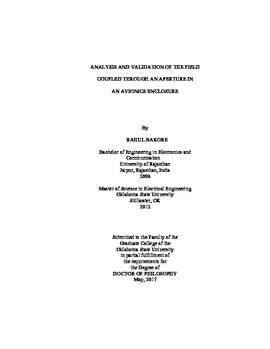| dc.contributor.advisor | West, James C. | |
| dc.contributor.author | Bakore, Rahul | |
| dc.date.accessioned | 2018-03-13T18:14:53Z | |
| dc.date.available | 2018-03-13T18:14:53Z | |
| dc.date.issued | 2017-05 | |
| dc.identifier.uri | https://hdl.handle.net/11244/54479 | |
| dc.description.abstract | This work focused on accurately predicting the current response of an equipment under test (EUT) to a random electromagnetic field representing a threat source to model radio frequency directed energy weapons (RFDEWs). The modeled EUT consists of a single wire attached to the interior wall of a shielding enclosure that includes an aperture on one face. An in-house computational electromagnetic (CEM) code based on method of moments (MOM) and accelerated by the multi-level fast multipole algorithm (MLFMA), was enhanced through the implementation of first order vector basis functions that approximates the EUT surface current. The electric field integral equation (EFIE) is solved using MOM/MLFMA. Use of first-order basis functions gives a large savings in computational time over the previous implementation with zero-order Rao-Wilton-Glisson basis functions. A sample EUT was fabricated and tested within an anechoic chamber and a reverberation chamber over a wide frequency band. In the anechoic chamber measurements, the current response on the wire within the EUT due to a single uniform plane wave was found and compared with the numerical simulations. In the reverberation chamber measurements, the mean current magnitude excited on the wire within the EUT by a mechanically stirred random field was measured and compared with the numerical simulations. The measured scattering parameter between the source antenna and the EUT measurement port was used to derive the current response on the wire in both chambers. The numerically simulated currents agree very well with the measurements in both the anechoic and reverberation chambers over the measured frequency band, confirming the validity of the numerical approach for calculating EUT response due to a random field. | |
| dc.description.abstract | An artificial neural network (ANN) was trained that can rapidly provide the mean induced current response of an EUT due to a random field under different aperture configurations arbitrarily placed on one face of an EUT. However, ANN proved no better than simple linear interpolation in approximating the induced currents on EUTs that give strong resonances and nulls in the response. | |
| dc.format | application/pdf | |
| dc.language | en_US | |
| dc.rights | Copyright is held by the author who has granted the Oklahoma State University Library the non-exclusive right to share this material in its institutional repository. Contact Digital Library Services at lib-dls@okstate.edu or 405-744-9161 for the permission policy on the use, reproduction or distribution of this material. | |
| dc.title | Analysis and validation of the field coupled through an aperture in an avionics enclosure | |
| dc.contributor.committeeMember | Bunting, Charles F. | |
| dc.contributor.committeeMember | Scheets, George | |
| dc.contributor.committeeMember | Nandi, Satya | |
| osu.filename | BAKORE_okstate_0664D_15121.pdf | |
| osu.accesstype | Open Access | |
| dc.type.genre | Dissertation | |
| dc.type.material | Text | |
| thesis.degree.discipline | Electrical Engineering | |
| thesis.degree.grantor | Oklahoma State University | |
